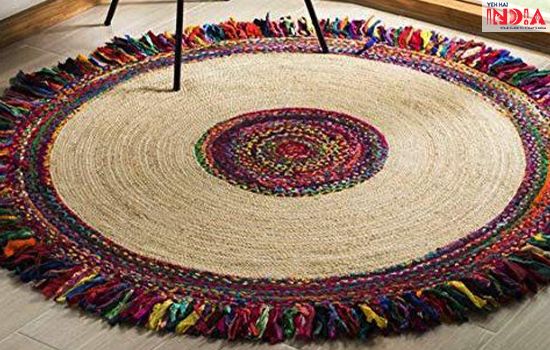GLOBAL DOMINANCE AND APPEAL OF INDIAN CARPETS
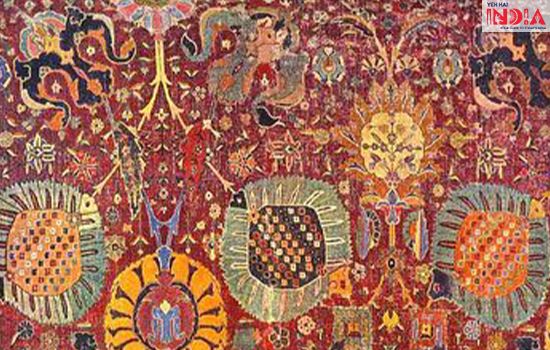
The immense wide range of hand-made rugs and carpets has exhibited the exquisite crafts and cultural richness of Indian civilisation over centuries. India consistently remains the world’s largest exporter of hand-made carpets, with the highest share in the global market.
Carpet Industry is one of the oldest industries of India and had an ancient heritage of carpet weaving and craftsmanship. Hand made rugs from India are woven in different varieties, which are influenced by the cultures, lifestyles and creative skills of various countries, eras and civilisations.
THE ORNAMENTAL FURNISHING OF HOME DECOR – INDIAN RUGS
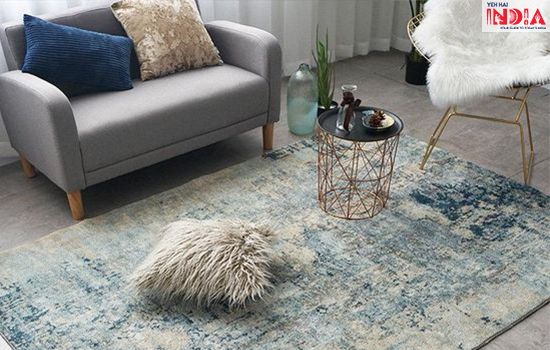
Traditional Indian Carpets have become the epitome of luxury flooring not only in India but all around the globe. Playing a crucial role in home décor furnishing everywhere around the world, Indian Carpets are undoubtedly one of the most significant factor that provides a room with a pleasant grandeur aura. Bring carpets in picture can modify the entire appearance and impression of a room or living space, instantly. Handmade Carpets bestow great warmth along with a touch of softness and coziness. Smart and sharp use of antique handmade carpets can revamp a dull-room to a lively and refreshing ambience. Hence, Indian carpets are regarded as the apotheosis of luxurious standards worldwide.
HISTORY OF CARPET
The story begins in the 16th century, when the Great Mughal Akbar took over the reign in India. To invite some glamor to the palace, Akbar brought to Agra, the capital, a few best carpet weavers from Persia.
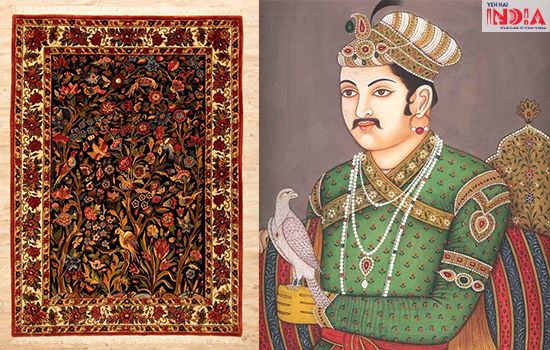
Indian Rugs and Akbar the Great
Thanks to their expertise, the Persian craftsmen were able to start the weaving industry in India practically from scratch. They helped to set up workshops for local people and arrange weaving areas in Agra, Delhi and Lahore.
High quality rugs made of silk, sheep wool, even cashmere, started to cover royal floors. Some of the exclusive ones included riches such as golden threads or gemstones. Although antique Indian rugs created during the Akbar reign copied the Persian style, they managed to smuggle in a bit of Indian essence. Usually inspired by the court life, they occasionally featured motifs such as exotic animals and decorative florals. Each antique Indian rug delighted with deep colours, thanks to pigments extracted from vegetable, plants and minerals.
The Development of Indian Rugs
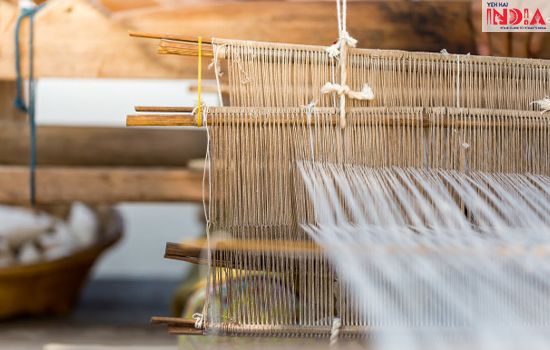
After Akbar, his son – Jahangir – ascended to the throne. Indian rugs created during this period reflect his taste and great fascination with exotic nature and the botanical world. Ornamental florals, herb motifs and earthy colour palette completely dominated the rug design then. The motifs became softer, more feminine in character and so sophisticated that they seemed almost life-like. Indian solicitude for detail, combined with original patterns and excellent quality, gained world-wide recognition.
This golden weaving era remained unchanged and lasted also through the times of Taj Mahal creator, Shan Jahan. Antique carpet design extended to picturing landscapes and scenic themes. The carpets still kept the enchanting floral accents. Also mystic animals showed up, introducing to Indian rugs a specific fairytale-like atmosphere. With all the dragons, mythical beasts and exotic fauna, the Indian design acquired a truly magical touch.
Indian Rugs Today
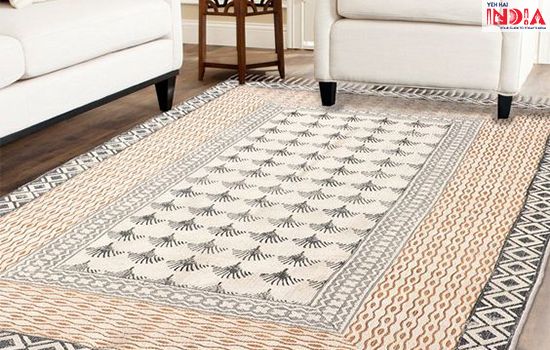
During the reign of Akbar and his successors, Indian rugs represented top-notch workmanship. A single piece was intricately made with exactly 4224 knots per square inch making the whole process extremely arduous. It sometimes took 15 years or more to complete a one complex design.
Unfortunately, during the 19th century, the quality of Indian weaving wonders noticeably decreased. The production slowly declined and high craftsmanship endured only in few regions, such as Srinagar, Amritsar and Agra. The reason? Mughal trends have become ubiquitous enough to be seen in the Western side markets.
Recommended Story – Handicrafts in India – Checkout the variety and craftsmanship
Only since India’s restoration of independence in 1947, the manufacturing of Indian carpets has slowly began to recover. Today, oriental rugs from India are still among the most qualitative and precious. However, what enchants the most is their magical, imaginative and deeply artistic character.
VARIETY OF RUGS CRAFTED IN INDIA
1. Indo Persian
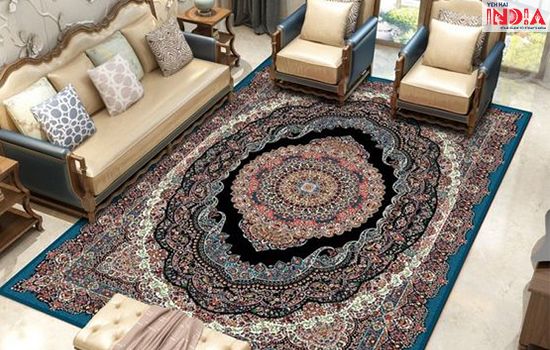
Originating from Iran, Persian rugs and carpets are woven in India since 16th Century. These carpets are usually hand-knotted and use a number of motifs in their design structure. The design source is primarily flowers, plants, culture, folklore, and royal lifestyles. Weaving Persian carpets is a complex laborious process. A single carpet can take from a few weeks up to year to complete, depending on the design fineness of knots, quality and size. Major production centres for Persian rugs in India are are carpet districts around Varanasi including Bhadohi, Mirzapur, Gopiganj. Other centres include Shahjahanpur, Jaipur and Agra.
2. Silk
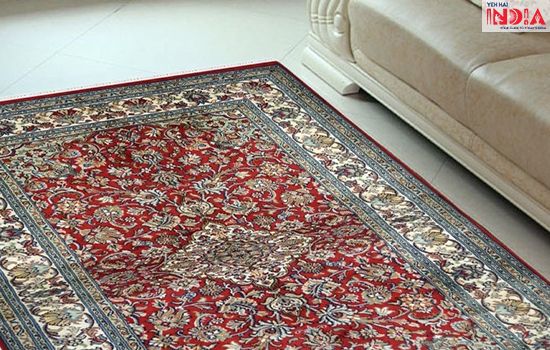
Indian silk carpets are highly valued among the world’s most discerning carpet buyers and weavers alike. Also very often referred to as Kashmiri carpets, these pure silk rugs have there original style with respect to colour, quality, design and durability. These exquisite creations are hand-knotted on warp threads, one at a time in accordance to to a strict code of colours; in the order of their appearance in the baton in the pattern. Silk carpets are very rich, traditional, aristocratic, and yet highly defined in terms of designs. More the number of knots per square inch, greater is their value and durability. Known to last for generation they hold their value and are uniquely produced all over Kashmir in India.
3. Wool and Silk
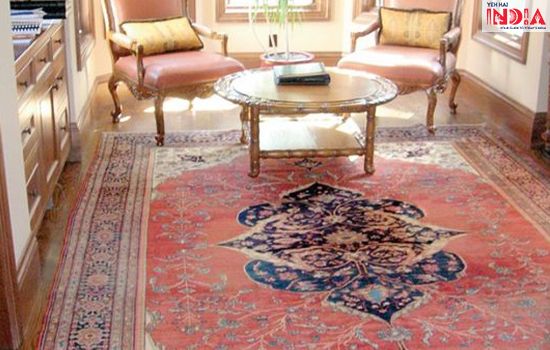
In this exotic rugs a combination of silk and wood is used to create magnificent designs. They are popular amongst discerning buyers as they are richer than wool and more cost efficient than pure silk rugs. In silk flower carpets, silk is used to accentuate the floral designs in the pile while the base is woven with woollen. Silk flower carpets are also considered to be modern versions of Persian carpets and promise a combination of affordability and aesthetic appeal. Regions where these carpets are made in India are Jaipur and Agra.
4. Hand Tuffed

Hand tuffing is the most common method of manufacturing rugs and carpets today for reasons of design, speed, and cost. Created with use of handheld tuffing tools, hand tuffed carpets have a reputation for being sturdy and wearing well over a period of time. Several popular styles of these rugs make use of comfortable pile created by the tuffing process. Base material used to produce stuffed rugs is a woven cloth, usually canvas that provide a strong base and makes them much more economical than hand knotted carpets. Major centres for tuffed carpet production in India are Panipat and Bhadohi.
5. Ziegler
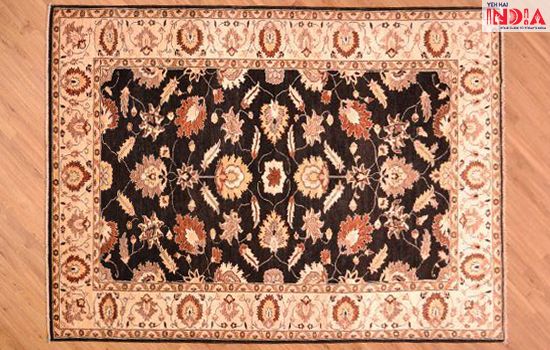
Ziegler is a unique variety of carpet with historic North West frontier influence. These hand knotted rugs and carpets are woven from handspun gazani wool yarn, most often in traditional floral designs. Low pile nearing zero and uneven surface are special design characteristics of these carpets. They blend well with the contemporary decor. These rugs are most often woven in traditional colours like beige, rust, red and brown but lately also of more subdued Western colours, used to meet the taste of modern urban consumers. In India these drugs are exclusively produced in Agra, the city of Taj Mahal.
6. Recycled
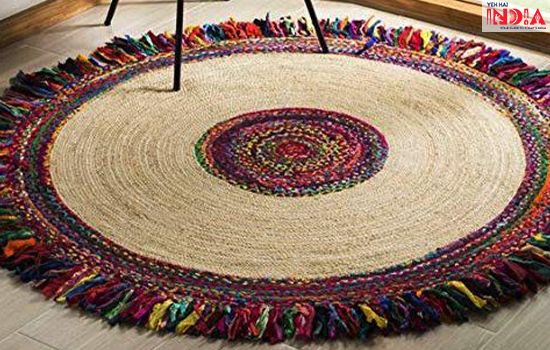
With the increasing concern for the environment and conserving natural resources, consumers all over the world are showing increasing preference for product made through recycling of raw materials, waste, used and discarded products. From fabric yarn and fibre waste of textiles to used garments, worn out tyres and tubes… number of such materials are used in India in a highly creative manner to produce rugs, carpets, durries and poofs and floor cushions. ‘Chindi‘ rugs from India in this category has been world famous for decades.
7. Kilim

The origin of Kilim drugs has been traced as far back as the fourth millennium BC. Kilims are produced by tightly interweaving the warp and weft strands of the weave to create a flat surface with no pile. Most kilim weaces are ‘weft-facing’, i.e., the horizontal weft strands are pulled tightly download so that they hide the vertical warp strands. Made from wool or cotton, Kilims have become increasingly collectible in recent years, with quality pieces commanding high prices. These rugs are mostly used for home decor or as prayer rugs. In India they are prominently produced in Mirzapur Rajasthan and Panipat.
Recommended Story – Are you an Indian traditional block prints lover? Here’s all you need to know
DESIGN SIGNIFICANCE
Patterns

Patterns are an integral part of the hand-made knotted carpet. Patterns like flowers, arabesques, rhomboids and occasional animal design were common produced and employed as design with varying degree of stylisation. Each of these designs has a unique meaning. Some of the designs and their significance is as follow:
Cypress tree: Survival in the afterlife.
Tree of Life: Eternal Life.
Anar: Pomegranate riches in abundance.
Camels: Wealth and happiness.
Peacock: The sacred bird.
Dove: Peace and good Omen.
Later, Persian style was amalgamated with Indian design giving rise to Indo-Islamic carpet. Today a wide variety of contemporary and sophisticated designs are available suiting according to the taste of the customers.
Colours

Dyes play an important role in carpets productions. Most of these dyes are derived from natural pigments. The vibrant rugs available in a rainbow palette had specific meaning according to the colour of the threads.
Symbolism of Colours on Traditional Indian Rugs
White: – The colour of mourning, death and grief (India, Persia and China). Also symbolic of peace and purity.
Black: – Revolt, Destruction (Islam).
Red: – Joy, Happiness, Wealth (Islam).
Yellow: – Imperial Colour.
Orange: – Devotion, Faithfulness or Piety (Islam).
Gold: – Power, Wealth (Islam and Persia).
Brown: – Fertility, Agricultural abundance (Islam).
Light Blue: – Power, Symbolic of Heaven (Persia).
Dark Blue: The heavenly colour and also colour of morning.
Nowadays, from pastels to bright hued carpets are available in the market to compliment the decor of any ambience.
BEST PLACES TO BUY A HAND-CRAFTED INDIAN CARPET
UTTAR PRADESH

Bhadohi, Mirzapur and Agra are the major handmade carpet manufacturing places in Uttar Pradesh. The speciality of Uttar Pradesh carpets and rugs is their unique designs with propounding wide colour range by which the carpet represent tale behind the design.
AGRA
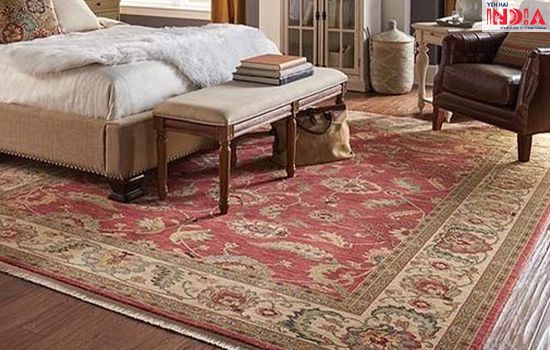
Agra was the first rug making region that was established in Uttar Pradesh during the Mughal time and is famous for using mostly vegetable dyes in its yarns. Being the centre of the Mughal kingdom it was the place where the first artisans from Persia were established and since then it has been known as the makers of authentic and amazing Persian rugs. The custom rugs of Agra give emphasis upon the elegance brought upon by surrounding bold floral outlines. Also known for the Turkmen and the Abussan varieties, which use bold realistic patterns in the design.
BHADOHI

The Bhadohi belt produces the maximum number of rugs in India which are well-known for its varied range and exclusive various knots and counts designs. Specialising in Woollen hand knotted Persian design, Into Nepal, Shaggy, tufted, loom knotted, Tibetan carpets, and durries, Bhadohi native weavers often include Taj Mahal in various natural tint colours which astound the on-lookers.
-MIRZAPUR
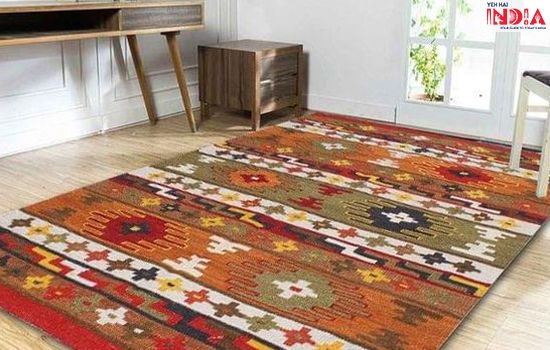
Mirzapur produces Hand-knotted and Hand-tuffed Crapets in wool, specialising in hand crafting woollen Durries, Kilims and Loom Carepts. The modern carpets made here have a touch of rainbow creativity in it and is known across the globe for this unique feature.
PANIPAT

Famed for the production of Durries, Tufted Carpets and a wide range if floor coverings including Shaggy rugs.
KASHMIR

Known as heaven of the Indian oriental carpets and rugs, Kashmir is famous for hand knotted pure silk carpets; they are a symbol of imbued quality and artistic expertise. Regarded as collector’s item, the silk and woollen carpets of Kashmir are matchless in their softness, design and craftsmanship. Representing the natural beauty of Kashmir weavers incorporates motifs of Chinar trees, Birds etc. The Mughal origin is evident in the Persian designs of traditional Kashmiri silk carpets which are woven with 324-900 knots per square inch or more.
RAJASTHAN
Carpets of Rajasthan are traditionally well known for fine-quality hand-knotted woollen fibres. Rajasthan being the residence of royal kings like Maharana Pratap, Jai Singh, Man Singh etc. which made sure that their palaces also had the luxurious handmade carpets for ornamental decoration.
Jaipur, Ajmer, and Bikaner are main centres for this craft in Rajasthan and are famous for handmade Durrie Rugs. Soft back and hard back carpets, wool-silk flower carpets, and hands-on knotted carpets are their pride and high sellers as well.
JAIPUR
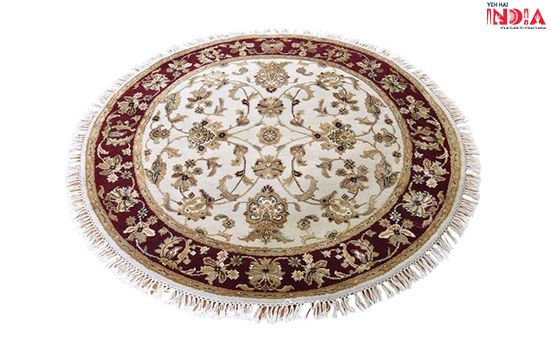
Jaipur was another major centre of the Mughal reign for carpet weaving. Carpets first began to be manufactured in Jaipur when weavers from Afghanistan started to settle in the royal ateliers in the 17th century. Ever since, they have flourished here, with their high-spirited colours and geometric motifs finding their way into showrooms across the globe.
Also Read – Tie & Dye Techniques in India- Bandhani, Ikat & Lehariya


